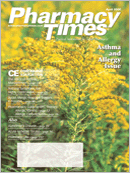Publication
Article
Pharmacy Times
VTE Prophylaxis: A Pharmacy Perspective
Author(s):
Venous thromboembolism (VTE), frequently silent and often deadly, is rampant: 260,000 cases of hospital-acquired VTE occur annually.1 Symptoms such as shortness of breath, pain, and inflammation can be harbingers of death; more than one third of deaths occur on the same day these symptoms are manifested.2 Effective thromboprophylaxis is underutilized,3 and pathologists believe that up to 63% of deep vein thrombosis (DVT) cases are missed clinically.4
The VTE Umbrella
VTE is the umbrella term encompassing DVT and pulmonary embolism (PE).5 Simultaneous stasis, hypercoagulability, and endothelial damage encourage clot formation. Most VTEs are lower-extremity DVTs, but they may break off and travel to become a PE.
Risk factors for which odds ratios are known appear in Table 1.6 Predisposing factors can develop at any time, not just at admission or in the perioperative period. Other risk factors include the following:
- Age (risk increases after age 40 but is especially high for patients over 70 years old)
- Pregnancy
- Oral contraceptive use
- Long-haul air travel
- Varicose veins
- Inherited and acquired clotting disorders
- Metabolic abnormalities
- Irritable bowel disease
- Nephrotic syndrome
Risk factors are additive, so an elderly person who has a malignancy and undergoes hip replacement surgery is at a higher risk than a similar but younger or cancer-free patient.
Patients who experience one VTE episode have a 30% chance of recurrence and are at an increased risk for life.7 Without adequate treatment, VTE can cause venous ulcers and postthrombotic syndrome (PTS).8 PTS occurs in up to 80% of adults with DVT.9,10 It includes swelling, pain, and local collateral vessel formation, and it may lead to limb dysfunction and skin ulceration.9-11
An acutely hospitalized patient's risk is 465 times greater than that of the general population, because acute immobilization (stasis) predisposes patients for VTE.6 (Bedridden individuals' risk declines after 3 months due to venous compensation.12) Risk is very high for 30 days postsurgery, but it remains elevated for >3 months.7 Among elders with DVT, 21% will die within a year, as will 39% of those with PE. Better screening is imperative.
Can Pharmacists Screen?
No valid VTE screening tool exists. The key is to question repeatedly, "Does this patient need VTE prophylaxis?" Although sick, elderly, or surgical patients are at an increased risk, everyone who is or recently has been hospitalized or immobilized should be screened. In general, pharmacists need to increase VTE awareness, ensure that patients ambulate or move, and suggest prophylaxis appropriately to prevent new or recurrent VTE.7
Anticoagulants
The anticoagulants currently available (warfarin, heparin, the low-molecularweight heparins [LMWHs], and fondaparinux) differ considerably. They are not interchangeable unit for unit or milligram for milligram, because they differ in manufacturing process, anti-Xa and anti-IIa activity, units, and dosage. All require periodic laboratory monitoring of complete blood count with platelets, urinalysis, and stool guaiac for signs of hemorrhage.7 Most anticoagulants interact with platelet inhibitors (aspirin, ticlopidine, clopidogrel), but this interaction does not strictly preclude simultaneous coadministration.
Warfarin
Warfarin, an inexpensive oral agent, is notorious for its interactions with food and prescription, OTC, and herbal agents. Its narrow therapeutic range requires frequent international normalized ratio (INR) and prothrombin time monitoring. Prudent patient selection, good patient education, and careful monitoring ensure safety, but repeated laboratory work can be a cost or convenience barrier for some outpatients. Monitoring must escalate in patients with increased hemorrhage risk; Table 2 describes early signs of bleeding.13,14 For short-term VTE treatment or prophylaxis, LMWHs are more cost-effective, although warfarin is more costeffective for long-term prophylaxis.15-18
The warfarin patient's diet must contain unfluctuating, consistent amounts of vitamin K-containing foods such as leafy green vegetables, fish, pork, green tea, and tomatoes. Pine nuts, cashews, prunes, liver, kiwi fruit, some cheeses, liquid dietary supplements,19,20 and smokeless (chewing) tobacco21 also have high vitamin K levels.
When nonsteroidal anti-inflammatory drugs (NSAIDs; even 81 mg of aspirin as cardioprophylaxis) and warfarin are administered concurrently, the relative bleeding risk is 13 times greater.22-24 Warfarin used to be held before dental visits. Today, dentists often allow uninterrupted warfarin, provided that an INR measured within 24 hours of the visit is =4.0 and only 1 dental extraction or preventive procedure is scheduled. Patients with renal or hepatic failure, hematologic disorders, or the need for multiple extractions or those receiving antineoplastic chemotherapy may need to have the dental work done on an inpatient basis.25,26
Heparin
Unfractionated heparin, which is hepatically cleared, is rarely employed as VTE prophylaxis due to its unpredictable subcutaneous absorption. It interferes with vitamin K synthesis and inhibits clotting factors Xa and IIa.27 As the heparin dose increases, the patient response may be nonlinear, increasing in intensity and duration. Heparin's narrow therapeutic window requires frequent monitoring of the activated partial thromboplastin time (aPTT).7 Up to 30% of patients develop heparin-induced thrombocytopenia, an apparently dose-related effect that may be intensified by concurrent drug therapy or comorbid conditions. Long-term heparin use may cause osteoporosis.7
Low-Molecular-Weight Heparins
The renally cleared LMWHs, which are heparin fragments, have less affinity for plasma proteins and vascular endothelium than heparin, making them more bioavailable and more predictable and less likely to cause thrombocytopenia or osteoporosis.7,28 Concurrent administration of NSAIDs increases bleeding risk. LMWHs are administered subcutaneously. Measuring INRs and aPTTs is unnecessary in most patients. In obese patients or in those with renal failure, anti-Xa levels can guide LMWH dosing.29
Fondaparinux
Fondaparinux also is given subcutaneously in a fixed dose, and it requires only standard anticoagulant monitoring in most patients. Its elimination is prolonged in patients over age 75 or in those with renal impairment. It should be used with caution in patients weighing <50 kg (110 lb).30
Future Directions
A recent survey31 found that physicians often are unfamiliar with lower-extremity venous anatomy and current treatment standards for VTE. Another study20 found that many physicians, pharmacists, dietitians, and nurses who work with patients taking anticoagulant therapy that interferes with vitamin K are unfamiliar with dietary interactions.
Thus, pharmacists can fill this health care gap. Numerous resources are available describing prophylactic and chronic anticoagulation. One excellent and comprehensive source is the Society for Hospital Medicine's Venous Thromboembolism Resource Room, accessed at www.hospitalmedicine.org/AM/Template. cfm?Section=Quality_Improvement_ Resource_Rooms&Template=/CM/HTML Display.cfm&ContentID=6093. It uses all available evidence and quality-improvement precepts to provide actual tools to enhance VTE prevention. Current recommendations from the American College of Chest Physicians also are available online.
Ms. Wick is a senior clinical research pharmacist at the National Cancer Institute, National Institutes of Health, Bethesda, Md. Views expressed in this article are those of the author and not those of any government agency.
For a list of references, send a stamped, self-addressed envelope to: References Department, Attn. A. Stahl, Pharmacy Times, 241 Forsgate Drive, Jamesburg, NJ 08831; or send an e-mail request to: [email protected].

Newsletter
Stay informed on drug updates, treatment guidelines, and pharmacy practice trends—subscribe to Pharmacy Times for weekly clinical insights.






